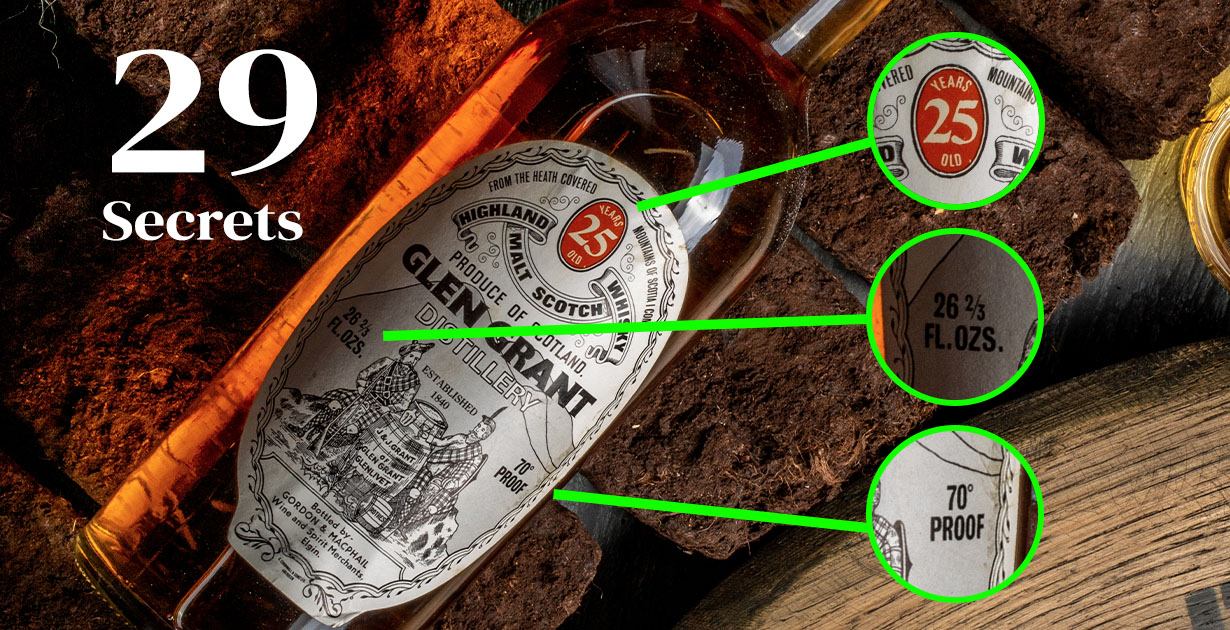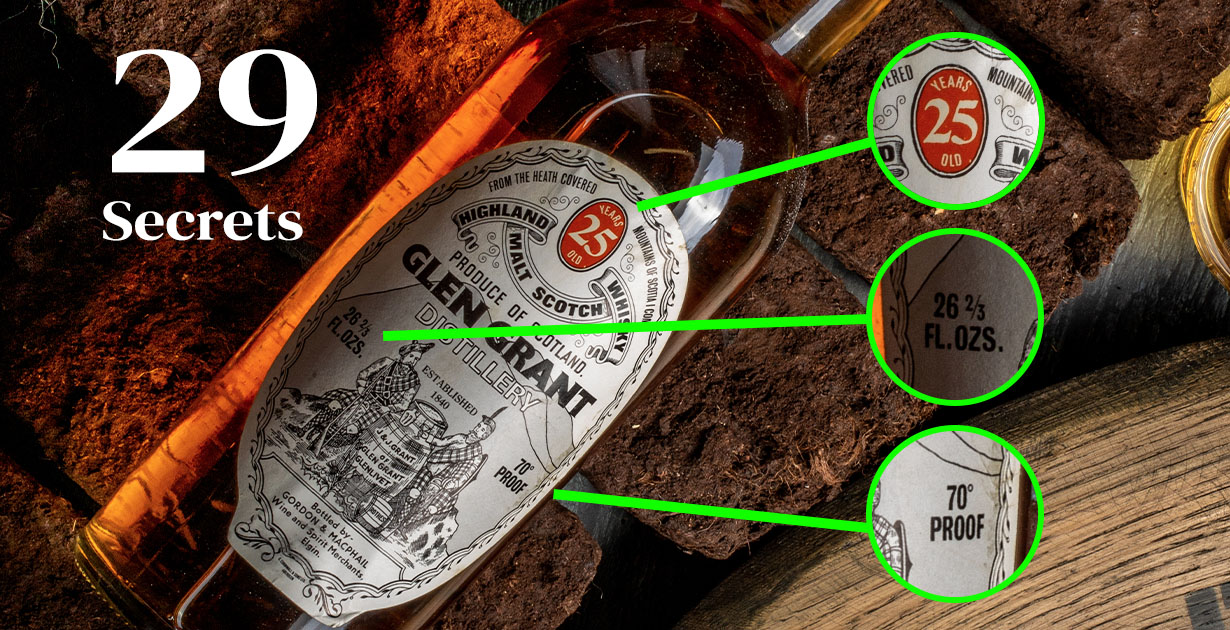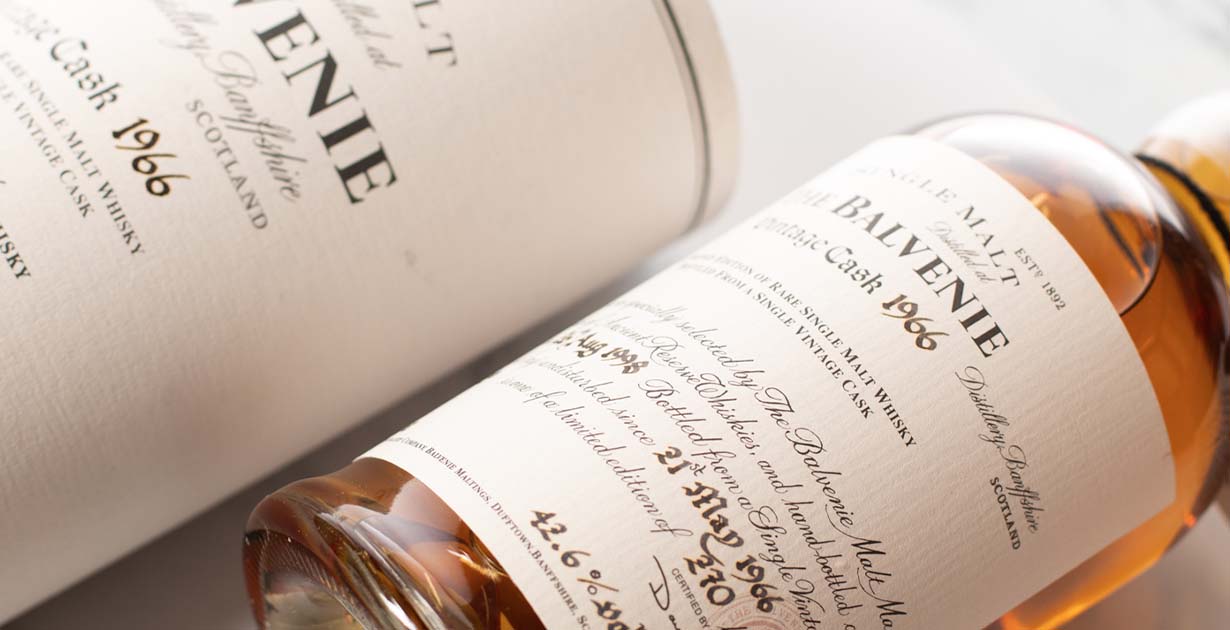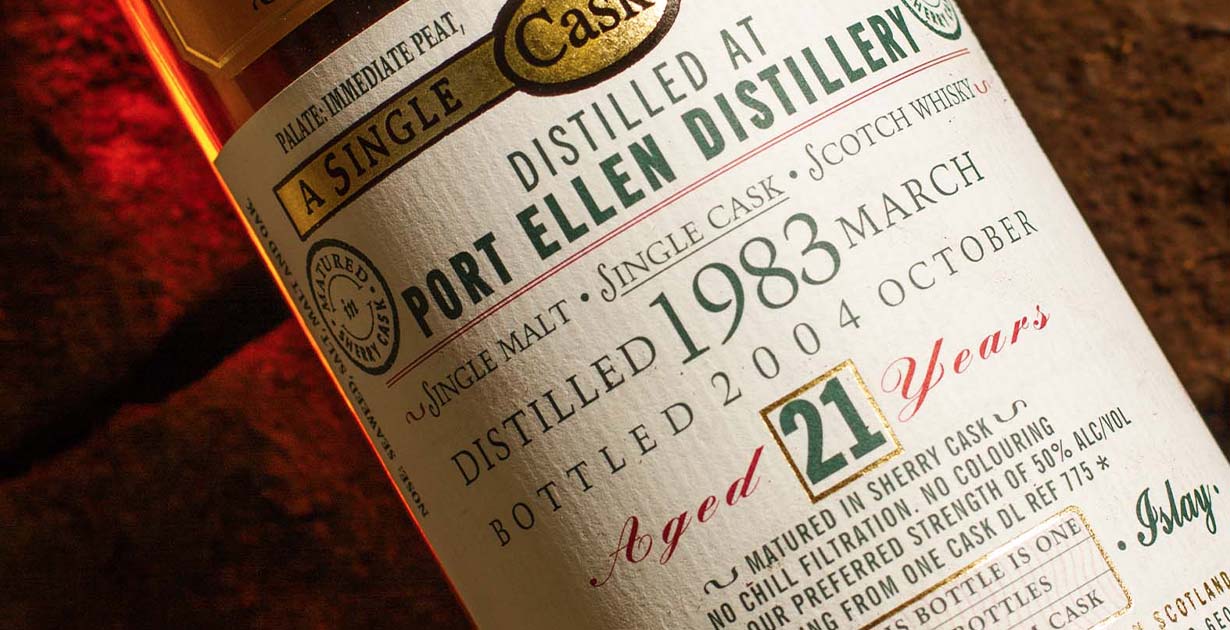

Think you know how to read a whisky label? Think again. While most can spot an age statement or ABV at a glance, there are actually up to 29 distinct pieces of information hidden in plain sight on every scotch whisky bottle.
Want to see if you can spot all 29 scotch-specific label elements? Let’s start with the numbers that matter most – these vital statistics will tell you everything from the whisky’s strength to its rarity.
Numbers
Age Statement
Look for a number followed by “Years Old” or “YO” on the front of your bottle. This age statement tells you the youngest whisky in the mix – every drop must be at least that old. The law requires this to be clearly displayed if the whisky is under 3 years old.
Can’t find a number? That’s a “No Age Statement” (NAS) whisky. While these might contain old whiskies, distilleries aren’t legally required to state age if all the whisky is over 3 years old.
Alcohol by Volume (ABV)
Look for a percentage (%) symbol on the label – this shows the Alcohol By Volume (ABV). By law, every scotch must display this and be at least 40% ABV. Most standard bottles sit between 40-46%, while “Cask Strength” whiskies come straight from the barrel without dilution, typically ranging from 55-65% ABV.
Cask Number
Look for “Cask #” or “Cask No.” followed by a number or code on the label. This appears most often on single cask releases, telling you exactly which barrel your whisky came from. For example, “Cask #1234” means every drop in your bottle came from that specific barrel.
Independent bottlers typically make these numbers prominent, while distillery releases might use them for special editions. Multi-cask releases won’t show a specific number, as they’re mixed from several barrels but they may show a range of cask numbers.
Batch Number
Look for “Batch” or “Batch No.” followed by a number, usually tucked away on the label or bottle. This tells you which production run your whisky comes from. Aberlour A’bunadh is a famous example – each batch number (now over 80) represents a slightly different expression, with enthusiasts often comparing subtle variations between releases. Batch numbers are particularly important for non-age-statement whiskies where consistency isn’t the goal.
Bottling Date
Look for two different styles of bottling year on labels. The first is the ‘Annual Release’ format used by distilleries like The Macallan, where “2024 Release” means it’s that year’s official bottling of their 18-year-old. These yearly releases often vary slightly in character and value, with collectors tracking specific years.
Independent bottlers typically show a more precise date (like “Bottled 14/03/2024”), which helps identify exact batches. This precision is particularly important for single cask releases where every bottle comes from the same day’s bottling.

Volume (e.g., 70cl, 750ml)
Look for the volume measurement, typically found at the bottom of the label. While 70cl is standard in the UK and EU today, and 750ml in the U.S., older bottles might show imperial measurements like 26 2/3 fl oz. This standardization only came into effect in 1980 for the UK market. Travel retail (duty-free) often features 1L bottles. By law, all scotch whisky labels must clearly display the volume.
Vintage
Look for a single year on the label, which indicates when the whisky was distilled – not when it was bottled. Unlike wine vintages, scotch vintage statements do not impact the quality and were popularised by distilleries like The Macallan with its Anniversary Malts. While not legally required, if stated, the vintage must be accurate and verifiable through production records.
Distillation Date
Look for the complete distillation date (day/month/year) typically displayed prominently on independent bottler labels or limited releases. This precise date tells you exactly when the spirit first came off the stills. While vintage shows just the year, distillation dates give collectors and enthusiasts the full details of the whisky’s birth date. It’s not legally required but must be accurate if stated.
Limited Edition
Look for “Bottle X of Y” typically displayed prominently on the label, where Y represents the total number of bottles in the release. Most common on single cask bottlings, which naturally have a finite number of bottles. While not legally required, these numbers help authenticate rare releases and are particularly valued by collectors. Some distilleries also number larger limited releases of vatted whiskies.
Names
Brand Name
Look for the prominent brand name displayed on the label – this might be a blend name like Johnnie Walker or a single malt brand like The Macallan. By law, this must be clearly visible and match the registered trademark. Some brands evolved from family names (Johnnie Walker) while others come from distillery names (The Macallan). The brand name helps identify the whisky’s producer and ownership.
Bottler Name
Look for the bottler’s name, often displayed less prominently than the distillery name on independent releases. Companies like Gordon & MacPhail, Cadenhead’s, or Signatory Vintage buy casks from distilleries and bottle them under their own label. By law, independent bottlers must clearly identify themselves on the label to distinguish their products from official distillery releases. This helps consumers identify who selected and bottled the whisky.
Distillery Name
Look for “Distilled at” on independent bottler labels or simply the distillery name on official releases. Some brands, like Singleton, specify which of their facilities produced the whisky (Dufftown, Glen Ord or Glendullan). By law, if a whisky claims to be from a specific distillery, it must be wholly produced there.
Producer /Distiller
Look for the company name (often in smaller text) that owns the brand or distillery, such as Diageo, Pernod Ricard, or William Grant & Sons. By law, every scotch whisky label must display who’s legally responsible for the product – this might be different from both the brand name and distillery name. Often found at the bottom of the label or back label, sometimes alongside the company’s registered office address.
Region
Look for the whisky region on the label – often displayed proudly as part of the whisky’s identity. Scotch whisky has five protected regional designations: Highlands (including Islands except Islay), Lowlands, Speyside, Campbeltown, and Islay. By law, if a region is stated, the whisky must be entirely distilled in that region.

Specific Wood Type (beyond cask)
When a whisky label mentions specific wood types like American Oak (Quercus alba) or European Oak (Quercus robur), it gives you insight into the whisky’s flavor profile. While not legally required, distillers include this information because different oak species impart distinct characteristics. American oak typically delivers vanilla and coconut notes, while European oak offers spicier, dried fruit flavors. Look for these details in the product description or near cask information on the label.
Limited Edition/Special Release
Terms like “Special Release” or unique names (e.g., “Horizon,” “Ardbog,”) indicate a whisky that differs from the distillery’s standard offerings. While not legally required, these names help identify specific bottlings and often hint at the whisky’s character or production method. You’ll typically find this prominently displayed on the front label, sometimes accompanied by a year or batch number. For collectors and enthusiasts, these names are essential for identifying specific releases in a distillery’s portfolio.
Barley Varieties
Many premium scotch whisky producers now proudly display their barley variety on labels, though it’s not a legal requirement. You’ll often spot terms like ‘Concerto’, ‘Laureate’ or ‘Optic’ barley, particularly on limited releases. The legendary Springbank Local Barley series takes this further, specifying not just the variety but even the local farm where it was grown – a testament to terroir’s emerging importance in whisky. For newcomers, while barley type can influence flavor, it’s more about understanding the distillery’s commitment to transparency and craftsmanship.
Season of Distillation
On premium bottlings, particularly single cask releases, you might spot references to the distillation season. Collections like Glenfarclas Family Casks and McGibbons Provenance series often highlight whether the spirit was distilled in spring, summer, autumn, or winter. While not legally required, this detail offers insight into production conditions – summer distillations, for instance, can behave differently due to warmer temperatures affecting condensation. For curious drinkers, it’s an interesting detail that helps track how seasonal variations might influence the final whisky’s character.
Signatures
While not a legal requirement on scotch whisky labels, you’ll often find the Master Distiller’s signature prominently displayed, particularly on premium or limited releases. This personal endorsement has become increasingly common, following American bourbon’s tradition of highlighting their distilling talent. Notable examples include Rachel Barrie’s signature on GlenDronach and Billy Walker’s former endorsement on GlenAllachie bottles. For consumers, it’s both a mark of quality assurance and a connection to the creative force behind their dram – though some argue it’s more marketing than meaningful, as all distillery releases go through rigorous quality control regardless of signature.
Legal Requirements
Country of Origin (Scotland)
The term “Product of Scotland” or “Scotch Whisky” is a legal requirement that must appear on every bottle of scotch whisky. This protected geographical indication (PGI) guarantees the spirit was made entirely in Scotland following strict regulations, including a minimum 3-year maturation in oak casks within Scotland. You’ll find this statement clearly displayed on the front or back label – it’s one of the most important legal protections ensuring authenticity for consumers.
Duty Stickers
The duty stamp or sticker is a security mark that appears on bottles sold in the UK market, typically across the bottle cap or as a label. Until recently, this was a legal requirement showing that UK excise duty had been paid, helping combat counterfeit spirits. You’ll find it as either a physical stamp or a printed mark incorporating the “UK Duty Paid” text and a unique reference code. However, following the Spring 2024 Budget, this requirement is being phased out to reduce costs for producers.
Type of Scotch (Single Malt, Blended etc.)
The type of scotch must be clearly stated on the label according to Scotch Whisky Regulations 2009. Look for one of these legally defined categories:
- Single Malt Scotch Whisky: Made from 100% malted barley at a single distillery.
- Single Grain Scotch Whisky: Made at a single distillery using malted barley and other grains/cereals.
- Blended Malt Scotch Whisky: A blend of two or more single malt scotch whiskies from different distilleries (formerly called “Vatted Malt”).
- Blended Grain Scotch Whisky: A blend of two or more single grain scotch whiskies from different distilleries.
- Blended Scotch Whisky: A blend of one or more single malt scotch whiskies with one or more single grain Scotch whiskies.
This categorization must appear prominently on the label and can’t be substituted with alternative terms. It’s one of the most important legal requirements for scotch whisky labeling, helping consumers understand exactly what they’re purchasing.

Descriptive/Sensory Information
Cask Type/Wood Finish
You’ll often spot cask or wood finish details near the middle or bottom of the label, sometimes highlighted in bold text. This tells you what type of barrel aged your whisky – like ex-bourbon, sherry, or port casks. While not legally required, distilleries proudly display this because it hugely impacts flavor. Look for terms like ‘finished in’, ‘matured in’, or specific cask names like ‘Oloroso sherry casks.
Natural Colour
If a whisky label states “Natural Colour” or “No Added Colour,” it means the spirit’s hue comes solely from cask maturation, without the addition of E150a (caramel coloring). While adding caramel is legal and common in scotch whisky, producers must declare if they don’t use it. The infamous Loch Dhu, known as “the black whisky,” represents the extreme use of E150a, with its intense artificial black color serving as a cautionary tale about excessive caramel use. Natural color is particularly important to enthusiasts who believe caramel can affect the taste and want to judge age by authentic barrel-derived color.
Non-Chill Filtered
When a label states “Non-Chill Filtered,” it means the whisky hasn’t undergone the cosmetic process of chill filtration, which removes naturally occurring fatty acids and proteins that can cause cloudiness when the whisky is cold or diluted. While chill filtration creates a clearer spirit, many distilleries champion non-chill filtered whisky because it preserves natural flavor compounds and oily textures that contribute to mouthfeel and complexity. You may notice these whiskies become slightly cloudy with ice or water – this is perfectly normal and often seen as a mark of quality by enthusiasts.
Phenol Levels (PPM)
PPM (Phenol Parts per Million) appears on labels of peated whiskies to indicate smokiness levels. While not a legal requirement, it’s become a crucial marker for peat lovers, particularly on powerhouse releases like Bruichladdich’s Octomore series, which famously pushes PPM levels over 300. For newcomers to peated whisky, think of PPM as a ‘smoke scale’ – typical Islay malts like Ardbeg sit around 55 PPM, while Octomore holds the record as the world’s most heavily peated whisky. Higher numbers mean more intense smoky flavors, though aging can mellow this impact.
Tasting Notes/Flavor Descriptions
These descriptive notes on labels, while not legally required, help consumers understand the whisky’s flavor profile before purchase. Typically found on the back label or packaging, they can range from simple terms (“rich, fruity, smoky”) to elaborate descriptions of specific flavors (“Highland heather honey, Seville oranges, dark chocolate”). While subjective, these descriptions are usually crafted by the distillery’s expert tasting panel. For beginners, they provide useful reference points, though experienced drinkers often prefer to discover flavors themselves. Look for these notes on the back label or secondary packaging.
Marketing Information
Awards/Medals
Look for medals, stickers, or award mentions – these show competition success. The most respected awards include the International Wine & Spirits Competition (IWSC), San Francisco World Spirits Competition (SFWSC), World Whiskies Awards (WWA), and International Spirits Challenge (ISC). While impressive, remember awards often relate to specific years or batches, not necessarily the bottle you’re holding.
Bottle Specific Information
Bar Code
A barcode on your bottle indicates it’s part of regular retail distribution. No barcode? This could mean you’ve found something special – perhaps a distillery-exclusive, a very old bottle (barcodes weren’t widely used on spirits before the 1980s), or a small-batch release meant for specialist shops. Some premium limited editions still come without barcodes, particularly if they’re sold directly from the distillery.
Bottle Codes
Bottle codes, typically laser-etched around the base or on the glass/label, serve as the whisky’s production ‘fingerprint. These alphanumeric sequences help distilleries track production batches and bottling dates for quality control and recall purposes. Though some enthusiasts use these codes to identify specific batches or bottling periods, the format varies by producer and isn’t always publicly documented. Most codes include a combination of bottling date, batch number, and production line information. While online guides exist to decode these, they should be treated with caution as systems change and aren’t officially published.







